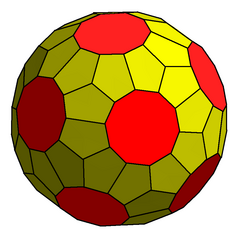| Truncated triakis icosahedron | |
|---|---|
 | |
| Conway notation | t10kI = dk10tD |
| Faces | 12 decagons 60 pentagons |
| Edges | 210 |
| Vertices | 140 |
| Dual | Decakis truncated dodecahedron |
| Vertex configuration | 12 (5.5.5) 60 (5.5.10) |
| Symmetry group | Ih |
| Properties | convex |
 Net | |
The truncated triakis icosahedron, or more precisely an order-10 truncated triakis icosahedron , is a convex polyhedron with 72 faces: 20 sets of 3 pentagons arranged in an icosahedral arrangement, with 12 decagons in the gaps.



